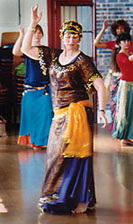|
| |
|
Raqs al Baladi

One of my favourite dancers,
Anne Ashcroft, teaching baladi
in the UK, 1994. Photo: L. Hawes
|
| Raqs al Baladi refers to an Egyptian
dance style that evolved in the early part of the 20th century. "Baladi"
means "my country" or "from my country", and in the
context of this dance, refers to its folkloric or country origins.
The evolution of raqs al baladi
coincided with waves of migration of rural people to the larger Egyptian
towns and cities. They brought with them their traditional instruments,
music and dance. In the cities they were influenced by western
music (in particular jazz and blues) and instruments (in particular
accordion, saxophone, clarinet and trumpet). This merger of traditional
Egyptian and modern western music gave birth to the distinctive baladi
sound. It is often referred to as "urbanised folk" music.
Baladi music is typified by several
distinct sections. Not all pieces or music have all the sections, and
they are not necessarily in the same order. Musicians and dancers are
usually improvising within a loose framework. |
Typical Baladi Repertoire |
| Dulab |
Musical
introduction |
| Tahmelah |
An light and
bright popular song. The dancer typically enters and displays lots of
personality. Simple walks, turns, bounces and gestures rather than
complicated moves. |
| Taqsim Hur |
Slow
improvisation to instruments such as saxophone, ney, accordian. This
section is usually more soulful in mood. |
| Awady |
A slow and
steady rhythm over which a more fluid melody develops. The melody is
usually the instrumental version of a baladi or saidi song. The dancer
can move between these two influences - the heavy beat or the softer
melody. Awady means "reed". |
| Sakkat |
These are sharp
staccato-like accents that usually appear at the beginning or end of the
awady. They may be interspersed with melodic instrumentation, silence or
drum rolls. |
| Tet |
A repetitive
fast beat with a climatic energy. |
| Engrar |
The pull - a
quicker rhythm that extends the tett. There is typically a solo
instrument such as a ney that plays over the rhythm and gives the engrar
a more fluid feel. |
| Tabla Solo |
Drum solo |
| Final Song |
Similar to the
tamelah. |
Raqs al Baladi Personalities
When dancing baladi style, the dancer
usually adopts typical Egyptian female personalities
to suit the contrasting emotions of the music. Dancers tend to naturally
lean to one particular personality but in the course of a baladi piece
of music, they may display several shades.
Dall'ua - playful woman
Bint el Beledi - innocent
country girl
Fellaha - country woman
Ma'alimah - boss woman
Alma - wise or learned woman
Ya Walla or Ya Wadd - tomboy |
References
The Birth of Baladi by Katrina Robinson
- The Hilal School of Raqs Sharqi Newsletter 1994
Understanding Raqs al Baladi by Hossam
Ramzy - Habibi magazine 1994
Andalus (Judy Lees) Class Notes
Lesley Jolley Class Notes |
|